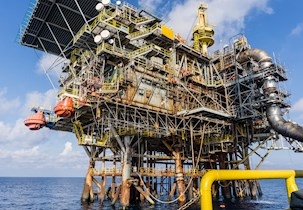Cathodic protection (CP) services
We provide a wide range of cathodic protection (CP) services and solutions that prevent and control corrosion as a part of asset integrity management.
Cathodic protection services and solutions
In order to prevent corrosion from damaging and tearing down valuable assets, cathodic protection systems are installed. We have more than 35 years of experience within cathodic protection and offer various types of solutions.
We offer the following CP solutions:
- CP modelling
- CP design
- FiGS CP survey /CP inspection
- CP of stainless steels
- Retrofit & life extension
- CP management and consulting
Many of these services draw from our in-house developed computer software, SeaCorrTM, which is designed to simulate CP systems.We also provide solutions for stainless steels, which in many cases are in fact prone to corrosion. Our combination of practical and theoretical approaches provides more accurate results, which is important when considering inspection intervals and life extension studies.
CP modelling
We provide cathodic protection modelling of all types of structures and pipelines. Our experts have developed a powerful software solution for this purpose, SeaCorrTM , which can be used to simulate a wide range of structures. The main objective of CP modelling is to demonstrate the actual performance of a CP system.
We simulate CP performance throughout its service life on structures with or without coating, using sacrificial anodes, impressed current as well as hybrid systems. SeaCorrTM is an excellent tool to use when considering life extension. It utilises our unique database with real life data in order to simulate the exact amount of retrofit anodes needed. This comprehensive approach gives us a competitive edge with regard to the quality and reliability of our CP modelling results. In addition we can verify CP designs, using design code values.
Typical cases evaluated by CP modelling:
- Current shadow effects, current drain and anode distribution issues
- Uneven anode consumption
- Over or under protection
- Protection in confined areas, small annuluses, etc.
- Galvanic corrosion
- Anode interference
- Interaction between connected structures
- Pipeline attenuation
With CP modelling, you can try out different scenarios in order to ensure the optimal protection of your asset.
CP Design
When designing a structure, whether it’s a new one, a retrofit modification or a life extension, it is important to ensure full cathodic protection throughout its entire design life. This is achieved through a proper cathodic protection design, where the required amounts of anodes are calculated, and anode placement is determined.
We hold a large team of experts, with experience from deep waters to onshore facilities, and from case studies to research and development. We provide CP design and evaluations of jackets, subsea structures, pipelines, FPSOs, semi submersibles, wind turbine foundations, caissons and other confined areas, chain connectors and more.
Our design and modelling experience combined with on-site inspection allows us to keep CP retrofit cost at a minimum, as well as ensuring optimal operation.
Our services within CP design include:
- Traditional CP design with both impressed current and sacrificial anodes
- CP design verification
- CP retrofit design
- Anode protection range and attenuation calculations
- CP design of stainless steels (see RCP further down)
- Material compatibility with cathodic protection systems
FiGS CP survey of subsea structures and pipelines
FiGS® CP survey is a unique approach to integrity management and life extension of offshore structures and pipelines with cathodic protection (CP). On both exposed and buried pipelines and structures, it provides an accurate condition assessment and detects even minor coating damages. FiGS® is a field gradient sensor that measures current output from anodes, current density of steels and current drain, along with a potential profile of buried pipelines.
Performing a FiGS® CP survey provides you with an accurate image of the assets condition, which allows for qualified decisions and substantial cost savings when considering life extension and anode replacement. This approach heavily increases the return on your investment, while providing you with the confidence level you deserve.
Key features include:
- Measurement of current output from anodes
- Measurement of current density on structures (bare steel, coated steel and concrete) and pipelines
- Detection of coating defects on structures and pipelines, including buried pipelines
- Measurement of current drain to buried structures such as piles and wells
Other CP measurements
We also carry out subsea CP measurements by various methods, including drop cell surveys, stabbing and more.
Cathodic protection of stainless steels / materials used in chlorinated seawater and produced water systems
Resistor controlled Cathodic Protection (RCP) prevents internal corrosion of stainless steels. It is highly applicable in chlorinated seawater and produced water systems that are likely to experience severe corrosion, which in turn may increase service cost. The system is based on sacrificial anodes with resistors that control the anode output. This enables very low current densities, allowing for significantly extended protection ranges from individual anodes. RCP anodes are easily installed and extend the service life of existing piping systems.
By using RCP, you are able to improve the first time investment costs (CAPEX) with the addition of a smaller replacement cost during the operational phase and allow for the use of inexpensive, low alloyed, stainless steels as an alternative to expensive components. RCP can also be used to prevent galvanic corrosion in couplings between materials and corrosion of various highly alloyed steel components in sea water systems.
Resistor controlled Cathodic Protection design
RCP designis carried out through our simulation software, RCPSimTM. This modelling tool allows us to easily carry out mathematical calculations such as anode distribution, current density distribution, anode consumption and resistor values, all in one integrated model. Calculations are based on FDM (Finite Difference Method), where complex boundary conditions are handled by linearisation and iterations. RCPSimTM handles complex piping networks with branching pipes in various diameters, with heat exchangers, filters, valves and pumps implemented into one model.
Diode Controlled Cathodic Protection (DCP)
Diode controlled Cathodic Protection (DCP) is designed to protect high-strength and stainless steels, which are prone to hydrogen induced stress cracking (HISC). It uses diodes, which are Schottky rectifiers, specifically designed for this purpose. The diodes are used to maintain a sufficient potential drop between the anode and cathode, and to ensure that the potential is sufficiently negative to avoid the risk of corrosion.
The use of DCP with high-strength and stainless steels eliminates the risk of HISC from hydrogen production at the steel surface, resulting from the CP system. This means that you can choose from a wider range of materials when designing the pipeline.
The DCP package is a completely sealed unit designed to withstand hydrostatic pressure of 300 bars and mounted on a typical bracelet anode. For system design, pipeline attenuation calculations combined with sensitivity considerations are applied together with traditional CP calculations.
CP management
Proper CP management is important and necessary to stay in control of your cathodic protection system. Staying in control may result in improved cost efficiency with regard to inspection intervals and prevention of otherwise unforeseen corrosion damages and breakdowns.
We offer full management of cathodic protection systems and RCP installations, including site inspection and inspection management, data analyses and reporting as well as various assessments of CP or RCP systems.
Utilising our vast experience and know-how within CP modelling and design, we take care of your CP system, ensuring that it runs as intended, giving an early warning of any failure modes. We combine our experience within inspection planning together with predictions of future development, often based on SeaCorrTM modelling, in order to produce inspection plans that are suited to your needs.
Information system
CMIS (Corrosion Management Information System) is a web-based data management system that allows us to share CP/RCP inspection, monitoring data and more with all relevant personnel. You can even compare inspection data and monitoring data with results from CP simulations and what-if analyses, given that these results are available. Dedicated personnel receive an e-mail notification whenever a report has been uploaded, or if an action has been assigned to them. CMIS shows the system status as traffic light colours for easy status review and interpretation.
Consultancy and expertise
Our vast experience within asset integrity management makes us capable of making qualified decisions and evaluations. This, in addition to our variety of specialists within areas ranging from materials technology, structural integrity to monitoring and inspection, makes us a preferred partner and supplier to the offshore industry.
Do not hesitate to contact us if you would like to receive more information, or if you have any questions or inquiries.


